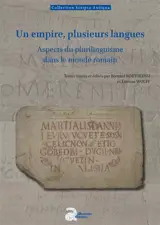
Un empire, plusieurs langues : aspects du plurilinguisme dans le monde romain
Dans sa quête d'unité dont la langue latine a été le symbole et le vecteur, l'imperium Romanum a été confronté à une hétérogénéité linguistique importante et multiforme. Étudier cette tension entre unité et hétérogénéité impose le recours à la pluridisciplinarité, sinon à l'interdisciplinarité. Sont convoquées au moins la linguistique, sous différents aspects (linguistique historique, sociolinguistique), l'histoire et l'archéologie, souvent fortement liées à la géographie, l'étude des textes, aussi bien littéraires que ceux qui relèvent de l'épigraphie.
Le présent ouvrage, fruit d'un colloque organisé à l'Université Paris Nanterre en 2023, présente des cas de figure aussi variés que complexes. Ceux-ci essaient d'être représentatifs des situations rencontrées dans différentes régions qui ont successivement connu la domination romaine : l'Italie elle-même avec les voisins étrusques et italiques ; la Gaule méridionale au croisement des Gaulois, Ibériques, Grecs et Romains ; la Gaule postérieure à la conquête avec son site emblématique d'Alésia ; l'Afrique du Nord où la conquête romaine se superpose aux conquêtes antérieures, laissant émerger les traces d'un substrat libyque - situation qui se retrouve en Orient pour les territoires passés successivement sous domination perse et grecque, mais aussi en Égypte.
Les relations de domination ont une expression linguistique : si le latin est effectivement la langue qu'impose le dominant dans le périmètre de son découpage administratif (les provinces), on en trouve également des échos dans les usages internes des communautés intégrées dans l'espace romain : hybridations graphiques, plurilinguisme entraînant l'usage du code-switching, voire l'adoption de l'onomastique romaine. Le contact linguistique s'accompagne aussi de transferts culturels perceptibles dans différents autres domaines : littéraire certes, mais aussi juridique ou religieux.
Malgré son idéal d'unité, le latin lui-même est multiforme, si bien que ses variations ont abouti à la genèse de langues multiples.
In its quest for unity, of which Latin was both the symbol and the vehicle, the imperium Romanum was confronted with many substantial forms of linguistic diversity. Any examination of the strain between unity and diversity requires a multidisciplinary if not interdisciplinary approach, involving, at the very least, linguistics in its various aspects such as historical linguistics and sociolinguistics ; history and archeology, which are often closely bound up with geography ; and the study of the written word, both literary and epigraphic.
This book results from a conference organized at the University of Paris Nanterre in 2023. It presents varied and complex cases representative of situations encountered in different regions that, in the course of time, came under Roman rule : Etruscan and Italic cities in Italy itself ; Mediterranean Gaul, where Gauls, Greeks, Romans and Iberians rubbed shoulders ; the provinces of Gaul after the Roman conquest, with the emblematic site of Alesia ; North Africa, where the Roman conquest followed on from Greek and Punic presence through which traces of a Libyan linguistic substrate emerged ; the eastern provinces, where a similar situation arose in lands previously under Persian and then Greek rule ; and in Egypt. Power relations find expression in language : while Latin was indeed the language imposed by the ruling power within the scope of its administration (the provinces), echoes of Rome's domination were also to be found in the language practices of communities integrated into the Roman world : hybrid graphical forms, plurilingualism entailing code-switching, and even the adoption of Roman onomastics. Linguistic contacts went along with cultural transfers that were noticeable in other spheres including literature obviously, but also law and religion.
Despite its ideal of unity, the Latin language itself was multiform, and its variations ultimately gave rise to multiple languages.
(sous réserve de confirmation)
Largeur : 17.0 cm
Epaisseur : 1.4 cm


